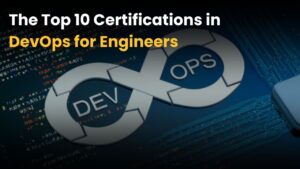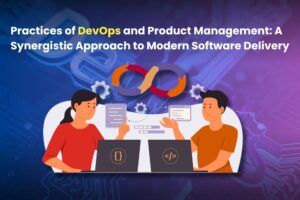To be competitive in the fast-paced digital world of today, companies need to provide high-quality software on time and with reliability. This requires a strategic blend of DevOps practices and product management methodologies. Product management concentrates on comprehending customer objectives, establishing product vision, and directing development activities toward business results, whereas DevOps stresses automation, teamwork, and continuous delivery.
This article explores the core practices of DevOps and product management, how they intersect, and the best ways to integrate them for successful product delivery.
Introduction: The Shift Toward Integrated Teams
Traditional development models often separated product teams from engineering and operations. Product managers defined features, developers built them, and operations deployed them. However, this siloed approach often led to misaligned priorities, slow delivery, and poor customer satisfaction.
The rise of Agile, Lean, and DevOps practices has blurred these boundaries. Today, successful organizations encourage cross-functional collaboration between product management, development, and operations teams. This integration helps align technical delivery with customer and business goals.
What is DevOps?
DevOps is a collection of procedures that blends IT operations (Ops) and software development (Dev). The objective is to consistently produce high-quality software while reducing the development lifecycle. DevOps promotes a shared accountability, automation, and teamwork culture.
Key DevOps Practices:
Continuous Integration (CI):
- Code is regularly integrated into a common repository by developers.
- Automated tests run with each commit to catch bugs early.
- Encourages the early identification of integration problems.
Continuous Delivery (CD):
- Software is always in a deployable state.
- Deployments are automated and can be triggered on demand.
- Reduces the time to market.
Infrastructure as Code (IaC):
- Infrastructure is provisioned and managed using code (e.g., Terraform, Ansible).
- Promotes repeatability, consistency, and version control.
Monitoring and Observability:
- Prometheus, Grafana, and ELK Stack are frequently used tools
- Real-time metrics, logs, and traces aid teams in promptly identifying and resolving problems.
Automation and Orchestration:
- Repetitive tasks (testing, deployment, scaling) are automated.
- Orchestration tools (like Kubernetes) manage containerized apps.
Feedback Loops:
- Fast feedback from users, testing, and monitoring helps improve continuously.
- Shortens the gap between code and customer experience.
What is product management?
Leading a product through its entire lifespan, from conception and development to launch and iteration, is the field of product management. Product managers (PMs) act as the voice of the customer, ensuring that development efforts align with user needs and business objectives.
Key Product Management Practices:
Customer Discovery and Research:
- PMs gather insights through interviews, surveys, and market analysis.
- Assists in locating possibilities and problems for customers.
Product Roadmapping:
- Strategic planning of features, goals, and timelines.
- Balances short-term needs with long-term vision.
Prioritization Frameworks:
- Techniques like MoSCoW, RICE, and Value vs. Effort help rank features.
- Ensures that high-impact issues are the focus of development.
User Story Mapping and Backlog Grooming:
- Breaks down product features into actionable user stories.
- Collaborates with engineers to clarify scope and dependencies.
Stakeholder Communication:
- Aligns engineering, marketing, sales, and leadership on goals.
- Keeps teams informed about progress, risks, and trade-offs.
Product Analytics and KPIs:
- Measures product performance through metrics (e.g., retention, engagement).
- Guides future development and improvement.
DevOps and Product Management: Bridging the Gap
At first glance, DevOps and product management may seem to serve different purposes. DevOps is rooted in engineering and delivery, while product management focuses on strategy and customer value. Nevertheless, combining these methods results in a development process that is more effective, customer-focused, and responsive.
Common Goals:
- Faster Time to Market: DevOps enables rapid releases; PMs ensure releases are valuable.
- Customer-Centric Delivery: PMs define features based on user needs; DevOps enables smooth deployment.
- Continuous Improvement: DevOps gathers operational feedback; PMs use this to refine the product.
How DevOps Empowers Product Management
Faster Experimentation:
- DevOps allows PMs to test ideas quickly with real users.
- A/B testing and feature flags enable rapid validation.
Data-Driven Decisions:
- Real-time monitoring helps PMs understand how features perform.
- Usage patterns and error logs inform future roadmaps.
Improved Collaboration:
- Shared tools (e.g., Jira, Confluence, Slack) promote transparency.
- DevOps culture encourages cross-functional teamwork.
Resilience and Reliability:
- With CI/CD and IaC, product features can be delivered reliably.
- Reduces downtime and improves user experience.
How Product Management Supports DevOps
Clear Prioritization:
- Helps DevOps teams focus on delivering high-value features first.
- Reduces waste and churn.
User Context:
- PMs provide user stories and personas that guide technical implementation.
- Helps DevOps teams understand the “why” behind the “what.”
Success Metrics:
- Defines KPIs and outcomes for each feature.
- Encourages DevOps teams to optimize for business impact, not just delivery.
Feedback Integration:
- PMs close the loop by feeding customer feedback into future iterations.
- Enables true continuous improvement.
Enroll in Pune’s Top DevOps Course Today!
Best Practices for Integrating DevOps and Product Management
1. Create Cross-Functional Teams
Build squads that include PMs, developers, QA, and operations. Empower them to own features from ideation to delivery and support.
2. Align on Goals and KPIs
Define shared goals such as release velocity, customer satisfaction, or feature adoption. Avoid siloed metrics.
3. Use Agile Frameworks
Iterative development is managed with the use of agile approaches like Scrum and Kanban. PMs and DevOps teams can plan and track work together using tools like Jira or Azure Boards.
4. Foster a Culture of Feedback
Encourage engineers and PMs to communicate openly. Use sprint retrospectives, user interviews, and incident reviews to learn and improve.
5. Leverage Feature Flags and Incremental Releases
Release features gradually to users using feature toggles. This allows PMs to test in production without full rollouts and gives DevOps more control.
6. Automate Everything Possible
Automation saves time and reduces errors. To cut down on manual labor, automate testing, deployment, infrastructure provisioning, and monitoring.
7. Invest in Observability Tools
Give PMs access to dashboards showing real-time data on feature usage, system health, and customer experience. Google Analytics, New Relic, and Datadog are useful tools.
Tools That Facilitate Integration
| Tool Category | Popular Tools |
| Project Management | Jira, Trello, Azure DevOps |
| Jira, Trello, Azure DevOps | Jenkins, GitHub Actions, GitLab CI |
| Infrastructure as Code | Terraform, Ansible, Pulumi |
| Monitoring & Logging | Prometheus, Grafana, ELK Stack |
| Feature Management | LaunchDarkly, Unleash |
| Product Analytics | Mixpanel, Amplitude, Google Analytics |
These tools help both DevOps and PMs collaborate effectively, share insights, and act quickly.
Real-World Example: Netflix
Netflix is often cited as a leader in combining DevOps and product management. Their engineers release thousands of changes daily using microservices, CI/CD, and canary deployments. PMs use real-time analytics to measure customer behavior and iterate on features. Their strong DevOps culture empowers product innovation at scale.
Challenges and How to Overcome Them
| Challenge | Solution |
| Misaligned Priorities | Hold regular planning meetings to sync product and engineering goals. |
| Lack of Visibility | Make use of reporting tools and shared dashboards. |
| Overemphasis on Speed | Balance delivery speed with quality and customer value. |
| Resistance to Change | Encourage a culture of learning and experimentation. |
Conclusion
The convergence of DevOps and product management marks a new era in software development. Organizations that integrate these practices effectively can deliver products faster, with higher quality, and with more relevance to user needs.
By aligning the strategic vision of product management with the technical capabilities of DevOps, businesses can create a continuous delivery pipeline of customer value. These two disciplines’ synergy is now required for competition, not a choice.
FAQs
Q1: Can DevOps and product management work in Agile environments?
Yes, Agile complements both. Agile focuses on iteration, and DevOps ensures fast, reliable delivery, while PM ensures value.
Q2: Should product managers learn DevOps tools?
Basic familiarity is helpful. Understanding pipelines, deployments, and monitoring improves collaboration and decision-making.
Q3: How often should PMs and DevOps engineers meet?
Ideally, they should collaborate daily during standups and throughout planning, grooming, and retrospectives.
Q4: What metrics should both roles share?
Feature adoption rate, deployment frequency, lead time, error rates, and customer satisfaction scores are key shared metrics.






